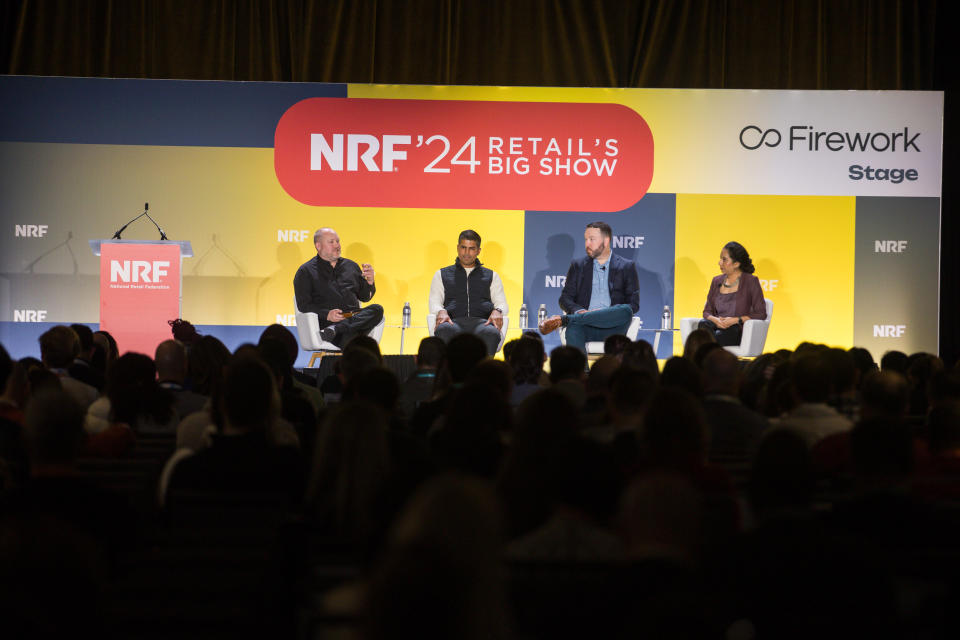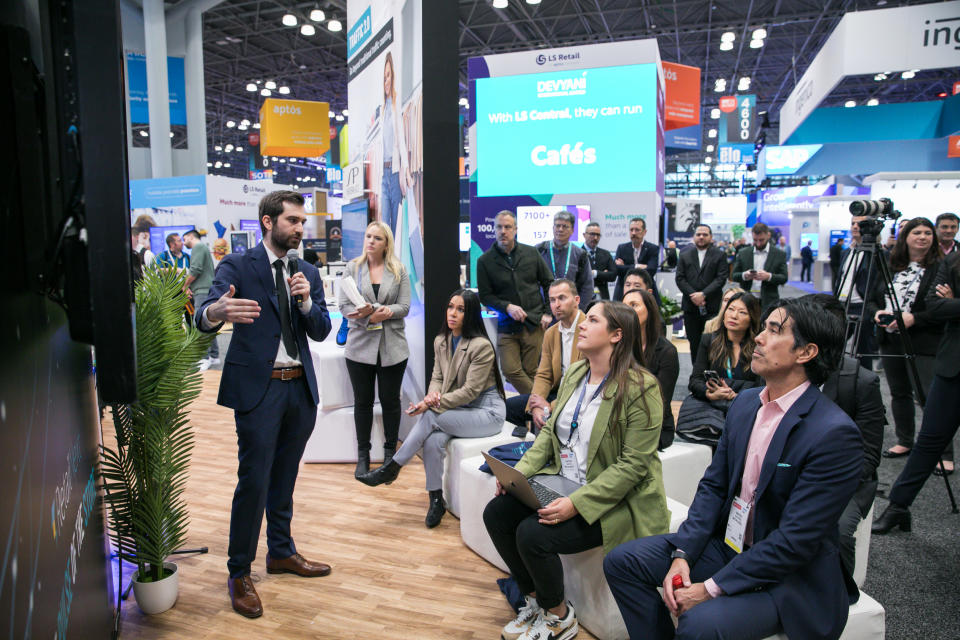NRF 2024: Retailers’ Minds Remain on Artificial Intelligence

40,000 attendees flooded New York’s Jacob K. Javits Center from Jan. 14 to 16 for NRF 2024—and nearly all of the attendees had one major topic on their minds: artificial intelligence.
AI and generative AI have begun to revolutionize how brands and retailers alike think about solving their most pressing problems. The buzz over AI has grown exponentially since NRF 2023, and practitioners and experts remain bullish about its potential to revolutionize industries.
More from Sourcing Journal
“A year ago, we were talking about AI here at this conference, but it wasn’t the No. 1 topic. It is now the No. 1 topic, and it’s being embedded in everything that we do, every technology that we’re leveraging, every technology that we will leverage,” said Karen Etzkorn, the chief information officer for Qurate Retail Group.
As brands ramp up their investments in and commitments for AI-based projects and systems in 2024, the show floors were chock full of solutions providers offering to incorporate AI into retailers’ businesses, and most sessions featured some mention of artificial intelligence.
Several ideas rang true throughout discussions at Retail’s Big Show: companies know AI has the power to revolutionize the customer experience; employee participation plays a huge part in bolstering that and without proper partners and infrastructure, progress will be slow and often, inaccurate.

Use Cases and the Customer Experience
Though adoption among retailers, particularly in fashion and apparel, has not happened as quickly as AI continues to iterate, many brands and companies have begun experimenting with the technology.
Some of those test-and-learn experiments have yielded strong early results for retailers, who have made it clear that their interests primarily lie in enriching the customer experience, whether online or in stores.
Samir Desai, Abercrombie & Fitch’s chief digital and technology officer, said the brand has been strategically evaluating how AI can help solve existing problems while simultaneously finding new use cases.
“I think the fundamental group of problems to be solved for our customer hasn’t radically changed over the last year or two because of generative AI—those problems are still the same,” he said. “With gen AI, I think it feels like we’ve now got more tools in our toolbox through which we can solve those problems, [and] there are new problems we’re able to solve.”
Desai said one example of a new problem brought to the surface by generative AI was product description copy; he noted that the brand hadn’t thought about solving that problem with technology a few years ago, but now, it employs generative AI’s assistance in creating efficient, automated descriptions.
To that same end, Josh Platt, senior vice president of product and user experience at Rue Gilt Groupe, said he expects AI to help solve two of consumers’ largest existing issues in fashion and apparel: returns and sizing.
Offering customers a more individualized, personalized experience seemed to be top of mind for many retailers at the conference. Brendan Witcher, vice president and principal analyst for Forrester Research, said that’s a trend that will only continue.
“I talk a lot about the move to individualization in my research. You need to move away from segmentation and personas—not necessarily stop doing those things, but we need to understand that that’s not the North Star of engagement. The North Star of engagement today is individualization, looking at the profile of the consumer,” Witcher said.
Some brands have already begun leveraging AI for just that.
Per Desai, the Harlem’s Fashion Row partner has also started using generative AI for stronger product recommendations on its site. In 2023, the brand launched an AI stylist tool that allows consumers to search by occasion for clothing.
“Somebody can ask a question like, ‘I’m going on a bachelor trip next weekend to Nashville, Tennessee, and I’m looking for an outfit to wear,’ and it will spit back a couple of different product recommendations,” he explained. “[It’s] a more original way of searching our product catalog, versus just three keywords, like, ‘Black leather jacket’ in a [search] box and then the customer doing all of the work navigating through all of the hundreds of results we give them.”
And in women’s intimates, where in-store try-ons and advice can be boon, one market leader has already committed to creating stronger customer experiences.
Victoria’s Secret recently announced a partnership with Google Cloud to offer personalized product recommendations to its consumers online. Murali Sundararajan, Victoria’s Secret’s chief information officer, said the brand wanted to enable a digital experience that paralleled in-store encounters.
“We wanted to bring the customer experience, what the customers typically go through in the store, and we wanted to mimic the same operations in the digital,” he said at NRF 2024.
As the Adore Me owner continues its journey toward AI adoption, Sundararajan said, it will focus on easing employees’ burdens in stores.
AI’s Effect on the Workforce
As brands and retailers integrate AI into all parts of their businesses, their workforces will be affected by the changes.
Results from a 2023 CNBC and SurveyMonkey Workforce survey show that 64 percent of U.S. workers indicated that they don’t use AI on the job at all. 2024 could change that.
Already, some companies have begun using AI to streamline operations in stores, distribution centers and call centers.
In a session with technology partner SOTI, Glenn Allison, Tractor Supply Company’s vice president of customer facing applications development, shared that the company has begun using AI to bolster its in-store employees’ knowledge of products.
It does that through its chatbot tool, which it calls Hey GURA. When faced with a question about a product’s attributes, employees can ask the system to explain what’s in a product, what it can be used for and more. Additionally, employees can use Hey GURA to make product recommendations. Employees access the chatbot via their handheld Honeywell devices.
Allison said that while using the chatbots in real time has helped bolster the customer experience, the company has seen another use case emerge: helping to train its workforce.
In a promotional video for Hey Gura, Tractor Supply explained that, “Team members can take the initiative and use Hey Gura in their down time to learn about products on their own, even when the customer doesn’t have a question. Hey Gura is a phenomenal tool for new, and even seasoned, team members.”
Allison said when Tractor Supply began evaluating potential use cases for generative AI, it knew the end result had to align with a real, defined need for its business.
“Gen AI, no doubt, there’s a lot of buzz that’s on the [show] floor. This is an example that’s real. We’re taking care of our store team members, so they can better take care of the customers and the criticality of being able to give them [a] legendary experience,” he said. “And that is genuine AI, not just buzz—genuine AI, purpose-built to take care of our store team members and customers.”
But when companies implement technology like this, one key consideration has to be employee adoption. If employees don’t add a new AI tool to their consideration set while working, the investment in buying or building it could be moot.
Jeff Courcelle, vice president of user experience and chief designer at MicroStrategy, which helps retailers create AI-powered apps and systems, said his experience shows that creating a useful, winning tool for employees most often happens by meeting them where they already are.
“You can build the most amazing artificial intelligence experience, but the challenge with that experience is getting [associates] to use it. If you just roll something out and give them yet another tool in their toolbox, which is already overloaded, the likelihood of them using it is actually very low,” Courcelle said in a session at NRF 2024.
Michael Relich, who previously served as PacSun’s co-CEO, said rather than developing something completely new, it could make sense to add on to what already exists.
“You have to implement it in a very mellow way, and the way I look at it, embed it in your existing applications,” Relich said.
Learning to incorporate AI into everyday operations could be paramount for employees hoping to prove their value among fears of job loss because of the tech.
Nearly all speakers who fielded questions about whether AI would take over humans’ jobs had the same answer: no. But for some, that “no” had a caveat: several speakers noted that while AI itself may not take a person’s job, a person who can successfully use AI will.

The Underlying Infrastructure
Though the excitement around AI continues to ramp up and flashy new use cases find their footing, practitioners and experts said the foundational data and information enterprises put into AI models could determine the success of the solutions.
“Good data is good decisions. Bring it back to the basics; understand your data foundation, whether it’s transactional, through a data warehouse, through that you’re working with is going to be storing that data for you,” said David Morton, director of enterprise data and analytics for Brooks Running.
Without clean, efficient data, practitioners argued, AI-based outputs could steer unsound decisions for a business.
Building in-house AI models to support a multifaceted business has proven not to be a quick route for many companies that have primary business interests outside of the technology arena.
As such, most major companies have turned to third-party software-as-a-service providers, like Google, SAP, Forter, Microsoft and more, to help them craft solutions, whether internally motivated or externally facing.
But finding the right service provider can prove challenging, especially when the market remains saturated with options.
Dale Cade, principal consultant at Columbus Consulting International, said for best outcomes, an enterprise should first evaluate its direct needs.
“If you just need shallow AI, don’t buy a personalized LLM,” he said, noting that the deeper an enterprise decides to go, the more it costs.
Randy Salley, Walmart’s former senior vice president of retail technology, said one of the most important assets is a technology provider’s understanding of the industry’s dynamics.
“I think the most important thing for me is, do they understand retail business, and what kind of experience they bring to the table that would allow me to have a great opportunity for success?” he said.
Companies testing and learning today will soon begin full-scale implementation. The consensus among leaders at NRF seemed to be that those who haven’t started experimentation could be missing out on the chance to increase revenue, create loyal customers and drive efficiency for their businesses.
“It’s a little like climate change, where you can put your head in the sand and pretend it’s not happening. Maybe you can do the same with AI. It’s coming, and so you have to embrace it, and you have to start to experiment across your business with both internal productivity opportunities and consumer-facing opportunities,” said Platt, the Rue Gilt Groupe executive.
Solve the daily Crossword

